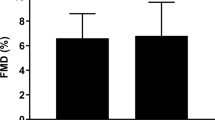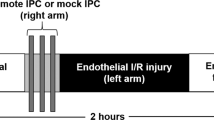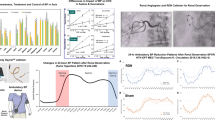Abstract
Although previous data showed that remote ischemic preconditioning (RIPC) has beneficial effect on blood pressure (BP) reduction, the efficacy of RIPC-induced decline in BP and the favorable humoral factors in hypertension is elusive. This present study is performed to evaluate whether RIPC reduces BP, improves microvascular endothelial function and increases circulating hSDF-1α generation in hypertension. Fifteen hypertensive patients received 3 periods of 5-min inflation/deflation of the forearm with a cuff on the upper arm daily for 30 days. Clinic and 24-h ambulatory blood pressure monitoring (ABPM) were examined before and after the end of this procedure. Microvascular endothelial function was measured by finger reactive hyperemia index (RHI) using the Endo-PAT 2000 device. The circulating hSDF-1α level was tested by ELISA. RIPC significantly decreased systolic BP (139.13 ± 6.68 versus 131.45 ± 7.45 mmHg) and diastolic BP (89.67 ± 4.98 versus 83.83 ± 6.65 mmHg), meanwhile 24-h ambulatory systolic and diastolic BP dropped from 136.33 ± 9.10 mmHg to 131.33 ± 7.12 mmHg and 87.60 ± 6.22 mmHg to 82.47 ± 4.47 mmHg respectively. RHI was improved (1.95 ± 0.34 versus 2.47 ± 0.44). Plasma hSDF-1α level was markedly increased after RIPC (1585.86 ± 167.17 versus 1719.54 ± 211.17 pg/ml). The increase in hSDF-1α level was associated with the fall in clinic and 24-h ABPM and rise in RHI. The present data suggests that RIPC may be a novel alternative or complementary intervention means to treat hypertension and protect endothelial function.
This is a preview of subscription content, access via your institution
Access options
Subscribe to this journal
Receive 12 digital issues and online access to articles
$119.00 per year
only $9.92 per issue
Buy this article
- Purchase on Springer Link
- Instant access to full article PDF
Prices may be subject to local taxes which are calculated during checkout




Similar content being viewed by others
References
Hong KN, Fuster V, Rosenson RS, Rosendorff C, Bhatt DL. How low to go with glucose, cholesterol, and blood pressure in primary prevention of CVD. J Am Coll Cardiol. 2017;70:2171–85.
Kloner RA. Clinical application of remote ischemic preconditioning. Circulation. 2009;119:776–8.
Moro L, Pedone C, Mondi A, Nunziata E, Antonelli IR. Effect of local and remote ischemic preconditioning on endothelial function in young people and healthy or hypertensive elderly people. Atherosclerosis. 2011;219:750–2.
Madias JE, Koulouridis I. Effect of repeat twice daily sessions of remote ischemic conditioning over the course of one week on blood pressure of a normotensive/prehypertensive subject. Int J Cardiol. 2014;176:1076–7.
Jones H, Hopkins N, Bailey TG, Green DJ, Cable NT, Thijssen DH. Seven-day remote ischemic preconditioning improves local and systemic endothelial function and microcirculation in healthy humans. Am J Hypertens. 2014;27:918–25.
Manchurov V, Ryazankina N, Khmara T, Skrypnik D, Reztsov R, Vasilieva E, et al. Remote ischemic preconditioning and endothelial function in patients with acute myocardial infarction and primary PCI. Am J Med. 2014;127:670–3.
Modena MG, Bonetti L, Coppi F, Bursi F, Rossi R. Prognostic role of reversible endothelial dysfunction in hypertensive postmenopausal women. J Am Coll Cardiol. 2002;40:505–10.
Pryds K, Nielsen RR, Jorsal A, Hansen MS, Ringgaard S, Refsgaard J, et al. Effect of long-term remote ischemic conditioning in patients with chronic ischemic heart failure. Basic Res Cardiol. 2017;112:67.
Zhao W, Meng R, Ma C, Hou B, Jiao L, Zhu F, et al. Safety and efficacy of remote ischemic preconditioning in patients with severe carotid artery stenosis before carotid artery stenting: a proof-of-concept, randomized controlled trial. Circulation. 2017;135:1325–35.
Zarbock A, Kellum JA, Van Aken H, Schmidt C, Kullmar M, Rosenberger P, et al. Long-term effects of remote ischemic preconditioning on kidney function in high-risk cardiac surgery patients: follow-up results from the renal RIP trial. Anesthesiology. 2017;126:787–98.
Chen L, Ding ML, Wu F, He W, Li J, Zhang XY, et al. Impaired endothelial repair capacity of early endothelial progenitor cells in hypertensive patients with primary hyperaldosteronemia: role of 5,6,7,8-tetrahydrobiopterin oxidation and endothelial nitric oxide synthase uncoupling. Hypertension. 2016;67:430–9.
Zhang XY, Su C, Cao Z, Xu SY, Xia WH, Xie WL, et al. CXCR7 upregulation is required for early endothelial progenitor cell-mediated endothelial repair in patients with hypertension. Hypertension. 2014;63:383–9.
Yang Z, Chen L, Su C, Xia WH, Wang Y, Wang JM, et al. Impaired endothelial progenitor cell activity is associated with reduced arterial elasticity in patients with essential hypertension. Clin Exp Hypertens. 2010;32:444–52.
Nagasawa T, Hirota S, Tachibana K, Takakura N, Nishikawa S, Kitamura Y, et al. Defects of B-cell lymphopoiesis and bone-marrow myelopoiesis in mice lacking the CXC chemokine PBSF/SDF-1. Nature. 1996;382:635–8.
Poredos P, Jezovnik MK. Testing endothelial function and its clinical relevance. J Atheroscler Thromb. 2013;20:1–8.
Kharbanda RK, Mortensen UM, White PA, Kristiansen SB, Schmidt MR, Hoschtitzky JA, et al. Transient limb ischemia induces remote ischemic preconditioning in vivo. Circulation. 2002;106:2881–3.
Madias JE. Effect of serial arm ischemic preconditioning sessions on the systemic blood pressure of a normotensive subject. Med Hypotheses. 2011;76:503–6.
Konukoglu D, Uzun H. Endothelial dysfunction and hypertension. Adv Exp Med Biol. 2017;956:511–40.
Lambert EA, Thomas CJ, Hemmes R, Eikelis N, Pathak A, Schlaich MP, et al. Sympathetic nervous response to ischemia-reperfusion injury in humans is altered with remote ischemic preconditioning. Am J Physiol Heart Circ Physiol. 2016;311:H364–H370.
Heusch G, Botker HE, Przyklenk K, Redington A, Yellon D. Remote ischemic conditioning. J Am Coll Cardiol. 2015;65:177–95.
Rassaf T, Totzeck M, Hendgen-Cotta UB, Shiva S, Heusch G, Kelm M. Circulating nitrite contributes to cardioprotection by remote ischemic preconditioning. Circ Res. 2014;114:1601–10.
Giricz Z, Varga ZV, Baranyai T, Sipos P, Paloczi K, Kittel A, et al. Cardioprotection by remote ischemic preconditioning of the rat heart is mediated by extracellular vesicles. J Mol Cell Cardiol. 2014;68:75–78.
Cai ZP, Parajuli N, Zheng X, Becker L. Remote ischemic preconditioning confers late protection against myocardial ischemia-reperfusion injury in mice by upregulating interleukin-10. Basic Res Cardiol. 2012;107:277.
Abbott JD, Huang Y, Liu D, Hickey R, Krause DS, Giordano FJ. Stromal cell-derived factor-1alpha plays a critical role in stem cell recruitment to the heart after myocardial infarction but is not sufficient to induce homing in the absence of injury. Circulation. 2004;110:3300–5.
Davidson SM, Selvaraj P, He D, Boi-Doku C, Yellon RL, Vicencio JM, et al. Remote ischaemic preconditioning involves signalling through the SDF-1alpha/CXCR4 signalling axis. Basic Res Cardiol. 2013;108:377.
Aimo A, Borrelli C, Giannoni A, Pastormerlo LE, Barison A, Mirizzi G, et al. Cardioprotection by remote ischemic conditioning: mechanisms and clinical evidences. World J Cardiol. 2015;7:621–32.
Acknowledgements
The work was supported financially by the National Nature Science Foundation of China (No. 31530023) and Science and Technology Plan Collaborative Innovation Key Projects of Guangzhou (No. 201704020212).
Author information
Authors and Affiliations
Corresponding author
Ethics declarations
Conflict of interest
The authors declare that they have no conflict of interest.
Additional information
Publisher’s note: Springer Nature remains neutral with regard to jurisdictional claims in published maps and institutional affiliations.
Supplementary information
Rights and permissions
About this article
Cite this article
Tong, Xz., Cui, Wf., Li, Y. et al. Chronic remote ischemic preconditioning-induced increase of circulating hSDF-1α level and its relation with reduction of blood pressure and protection endothelial function in hypertension. J Hum Hypertens 33, 856–862 (2019). https://doi.org/10.1038/s41371-018-0151-1
Received:
Revised:
Accepted:
Published:
Issue Date:
DOI: https://doi.org/10.1038/s41371-018-0151-1
This article is cited by
-
Gene expression of hemostasis biomarkers following HIIT and RIPC
Comparative Clinical Pathology (2024)



